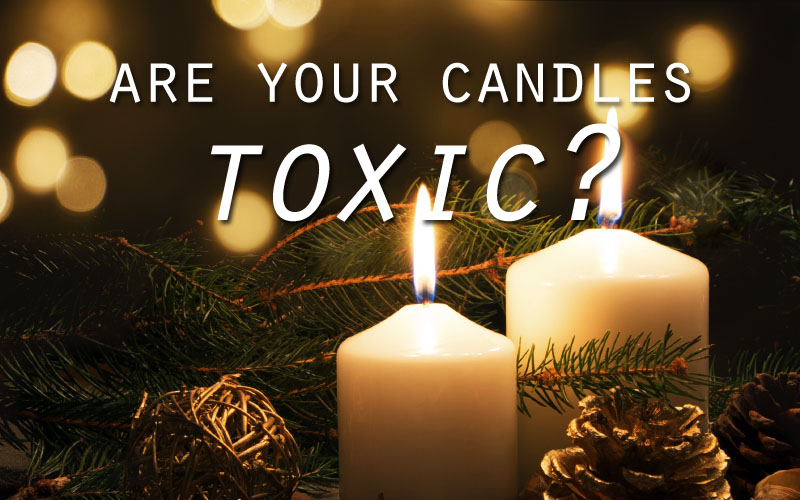
by guest blogger Ava Anderson, safe products advocate
Fall is upon us, and the holidays will be here before we know it. As the air grows crisper, the aisles in every store will begin to fill with the synthetic fragrance of fall harvest. While we shop, the smells of apple pie, pumpkin spice, and sugarplums will dance around us. But as pleasant as this might seem, there’s a darker side to the seemingly bright world of scented candles.
The truth is many people aren’t aware of what they’re actually burning (and inhaling!) when they light those pretty scented candles. That’s why I’ve put together a list of toxins to avoid when buying and burning scented candles:
1. The Wax
Most candles are made from paraffin wax. Paraffin wax starts literally at the “bottom of the barrel”—the bottom of an oil barrel. After petroleum is processed into diesel gasoline, motor oil, kerosene, and other “saleable” fuels, the rejected oil is separated through crystallization, heated, and mixed with one or more solvents, such as a ketone, and then cooled. The soot created by burning a paraffin wax candle in your home contains the same toxins found in diesel fuel. Stanford University’s aeronautics and astronautics department launched a rocket into space with paraffin as rocket fuel. (This is the same paraffin wax found in nail salons!)
The American Lung Association issued a warning in 2005 that paraffin candles can emit a dizzying array of known carcinogens, including acetaldehyde, formaldehyde, acetone, benzene, 2-butanone, carbon disulfide, carbon tetrachloride, creosol, chlorobenzene carbon monoxide, cyclopentene, ethylbenzene, phenol, styrene tetrachloroethene, toluene, and xylene. Researchers at the University of Michigan found that candles made from paraffin wax give off emissions that exceed the Environmental Protection Agency’s standards for outdoor air quality.
Instead: Look for coconut- or beeswax-based candles, preferably from organic, non-GMO sources. They can be more costly than paraffin, but either kind burns longer and cleaner than paraffin.
2. The Scent
Synthetic fragrances are primarily derived from petrochemicals. A 1986 report by the National Academy of Sciences explains that 95 percent of the chemicals used in synthetic fragrances are derived from petroleum and include benzene derivatives, aldehydes, and other known toxins capable of causing cancer, birth defects, central nervous system disorders, and allergic reactions. Manufacturers are allowed to legally hide their “trade secret” synthetic fragrance concoctions, many of which contain phthalates—known endocrine/hormone disruptors (EDCs). The World Health Organization recently called EDCs a global threat to fertility.
Instead: Look for candles scented with pure essential oils.
MORE: Five “Must-Knows” on the Dangers of Synthetic Fragrance
3. The Color
Many dyes are made from crude coal tar. This tar is the by-product created during the destructive distillation of bituminous coal. Benzene and toluene are just a few of the toxic by-products of coal tar dyes. Blue #1 and #2, Green #3, Red #3 and #40, and Yellow #5 and #6 are some of the most common synthetic dyes made from coal tar. The safety of added colors used to tint candles depends on the ingredients of the dye. However, most synthetic dyes will give off unsafe particles while burning.
Instead: Pass on the pretty colors and stick to chemical-dye-free candles.
MORE: 8 Toxic Products to Ban from Your Home Today
4. The Wick
Candlewicks are typically made from either “non-cored” (twisted fibers, look for cotton) or “cored” with metal wire inside the fiber for rigid support. Metal cores are most often made of cadmium, lead, zinc, or tin. Lead and cadmium bio-accumulate in the body, and lead can adversely affect the central nervous system, heart, and kidneys. Chronic exposure in adults is associated with endocrine and reproductive problems. Children are at higher risk, as lead exposure has also been linked with depressed intelligence and behavior problems in children. According to the EPA and the International Agency for Research on Cancer (IARC), cadmium inhalation is carcinogenic to humans. Cadmium is also known to be toxic to the liver, kidneys, bones, and immune and endocrine system.
A study in the Journal of the American Medical Association (published in 2000) indicated that candles with wicks containing lead were available at 12 different stores in the Washington-Baltimore area. Testing showed that the candle with the least lead would still produce enough lead concentration in the air in just 45 minutes to exceed the recommended daily lead limit for a normally active 6-year-old.
The researchers concluded that there is no reliable method to distinguish lead-containing wicks from other metal-cored wicks.
Instead: Look for candles with cotton wicks.
MORE: “Hormone Disruptors”: Not Just for Menopausal Mommas
 At the age of 15, Ava Anderson launched her safe line of personal care and home-cleaning products, Ava Anderson Non Toxic. Now in college, Ava is educating millions of American families annually on the issue of toxic chemicals in products through her line, which now includes baby, skin, hair, body, cosmetics, men’s, candles, bug, home, sun, pet, kids, garden, smile and auto products. An undergrad at Babson College in Wellesley, Massachusetts, Ava actively helps run her large company with over 80 employees and thousands of Ava Anderson Consultants in every state in the nation. Her goal is to force a paradigm shift on the issue of toxic chemicals in products—with your help.
At the age of 15, Ava Anderson launched her safe line of personal care and home-cleaning products, Ava Anderson Non Toxic. Now in college, Ava is educating millions of American families annually on the issue of toxic chemicals in products through her line, which now includes baby, skin, hair, body, cosmetics, men’s, candles, bug, home, sun, pet, kids, garden, smile and auto products. An undergrad at Babson College in Wellesley, Massachusetts, Ava actively helps run her large company with over 80 employees and thousands of Ava Anderson Consultants in every state in the nation. Her goal is to force a paradigm shift on the issue of toxic chemicals in products—with your help.




Wonderful article and just love Ava and her mission!
As a passionate candle manufacturer, I would like to add a few comments to support Ava’s article.
Unfortunately, the candle industry is not regulated and most “soy” candles are either blended with petrol based paraffin or synthetically produced fragrances. Why take an all natural soy wax, promote it like it’s 100% “natural” and mix it in with toxic perfumes to make it artificially smell like pumpkin spice or clean linen? Because it’s CHEAP.
Lighting a candle is special and creates a mood for the user to delight in. We are thinking about all the products we are consuming in our bodies, putting on our skin and breathing in when cleaning….it’s time for everyone to become educated on what they are breathing in from candles as well.
Paraffin wax is a petroleum by-product created when crude oil is refined into gasoline. It is a white, odorless solid that is formed into 10 lb. slabs. You will never know if it’s a paraffin blend because of color or texture. It must state 100% soy wax.
Today, they are approximately 95-100% synthetic (man-made) fragrances.” Using crude oil or turpentine oil as the base material, synthetics are usually derived from chemical reactions. There is no such thing as “natural fragrance” unless it states 100% pure essential oils.
I always say look for the following four things in a “scented” candle.
1. An “authentic” candle manufacturer that it is passionate about producing a clean product vs. a cheap product that just has expensive packaging.
2. Non GMO Soy Wax. Make sure it does say “blend”! It could be blended with paraffin (crude oil).
3. Cotton Wick. 45% of all imported candles are from China and some could contain lead.
4. 100% pure essential oils. Make sure it doesn’t say blend or all natural fragrance because there is no such thing. The only natural fragrance is 100% pure essential oils from plants and flowers.
Thank you! Stay authentic! 🙂
Thank you for helping us reach our family’s goal of going non-toxic this year! This article was extremely helpful!
My story began in the fall of 2014 when I was diagnosed with triple negative breast cancer. It shattered my world and everything I believed in – having been physically active, a non-smoker, a non-drinker and at my ideal weight. Then boom!
I began re-evaluating my lifestyle choices, my eating habits and my environment. It took me on a very different path. I left my day job and focused on my health. During the journey I was inspired to re-design my career and create something that would have value and purpose. Oddly enough it began with my passion for fragrant candles.
Scented candles have always been a part of my life and after discovering a large majority of mass marketed candles contain harmful chemicals and additives in their products, I was unwilling to simply walk away from using scented candles. Instead, I set out to design the perfect medium in order to create a highly fragrant, clean burning, pure and natural product that was safe for my family, my pets and the environment.
My pets were an integral part of my healing process and after nearly 18 months of research, I created a proprietary blend of 100% certified organic waxes. I sourced the highest quality essential and fragrant oils that are phthalate free, creating captivating scents of wax melts designed in the shape of a paw. Why the paw? To pay tribute to our furry friends who help us through life’s difficult times. In particular my 3 cats who were beside me and loved me unconditionally during the entire time. We also donate a portion of our profits to animal shelters.
I don’t know whether the frequent use of scented candles had any influence on my health prior to my diagnosis, but I do know that I will NEVER again use any scented candle/wax melt that isn’t 100% organic and natural. My health and that of my family and pets is far too precious to take the risk.
Thank you for creating a forum for women to share their stories. Please check out my new Paw Melts website and let me know what you think => http://www.pawmelts.com/
Carpe Diem
Sarah